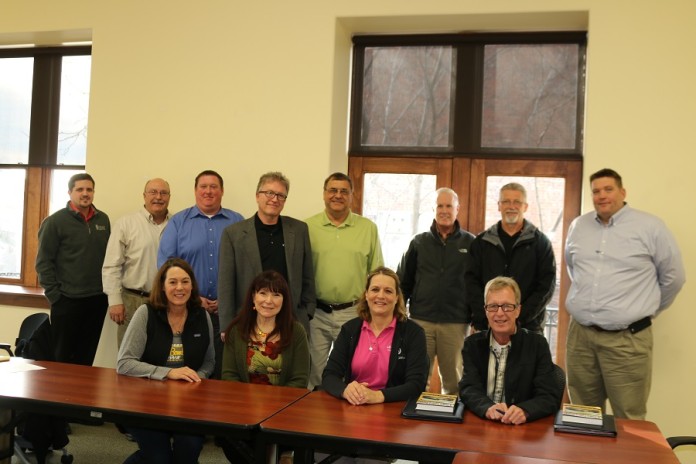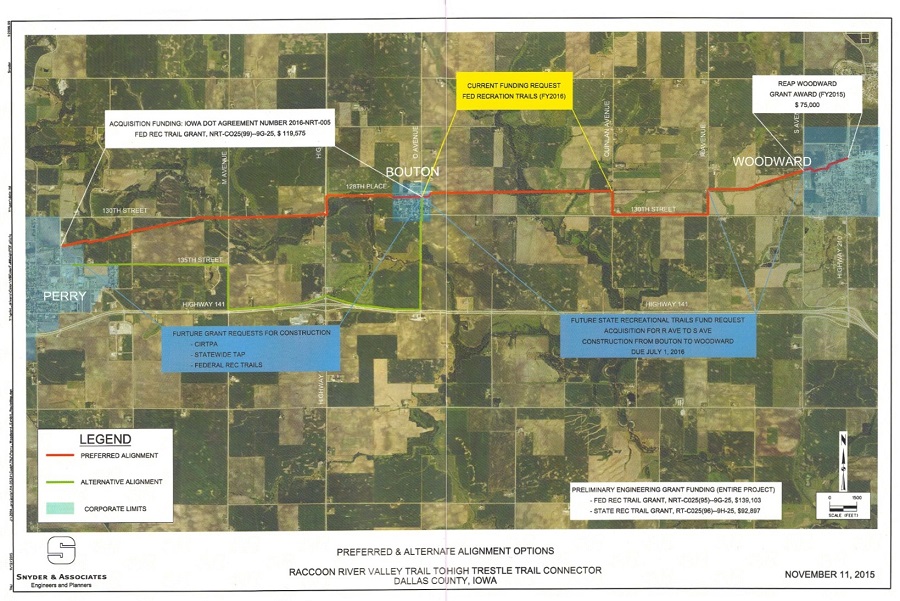
With a new funding stream for rural development from the U.S. Department of Agriculture (USDA) aimed specifically at regional projects, backers of the connector linking the High Trestle and Raccoon River Valley bike trails are looking to draft a regional plan embracing Perry, Bouton and Woodward in the hope of tapping the new federal funds.
In order to see whether the connector-trail project might be a good fit for USDA funding and to strategize ways to go about framing a regional plan, two USDA area specialists visited Perry Wednesday to meet with county, city and private-sector leaders interested in building the link trail.
USDA Area Specialists Mark Johnston of Indianola and Doug Grinberg of West Des Moines spent about an hour talking about USDA funding opportunities, including the new Strategic Economic and Community Development (SECD) program and Rural Business Development Grants (RBDG).
Former Perry City Administrator Butch Niebuhr, now consulting with Bolton and Menk engineering firm, helped to arrange and facilitate the meeting.
“I thought maybe we could set up a regional group that could access grants and or loans from the USDA in order to make that (bike trail) connection happen,” Niebuhr said.
Niebuhr was joined at the meeting by a variety of pro-connector trail representatives, including several members of a committee of local citizens who formed to promote the link trail: Jill Brosnahan, Joelle Miner and Larry Meachum.
County and city interests were represented by Greater Dallas County Development Alliance Executive Director Linda Wunch, Dallas County Conservation Board Executive Director Mike Wallace, Dallas County Conservation Board Chair Mark Powell, Perry Mayor Jay Pattee, Perry City Administrator Sven Peterson, Bolton and Menk Project Manager Matt Ferrier and Bolton and Menk Project Manager Chadd Kahlsdorf.
Attendees were soon swimming in the alphabet soup of federal programs. Section 6025 of the 2014 Farm Bill provided funding for the SECD program. The National Association of Development Organizations (NADO), representing more than 500 regional development organizations (RDOs) across the U.S., has partnered with the USDA on a useful webinar on the new funding program.
SECD emphasizes regional collaboration between cities, counties, rural electric and communications cooperatives or other entities. According to Sam Rikkers, deputy administrator in the USDA’s Rural-Business Cooperative, Congress had the foresight to develop SECD in order to fund “not just one city’s plan or one county’s plan but a plan that encompasses multiple groups, multiple jurisdictions.”
Once established and with a plan in hand, a regional entity — such as a Perry-Bouton-Woodward regional partnership — would have a leg up in chasing funding sources outside the USDA as well, such as dollars from the U.S. Department of Transportation (DOT), U.S. Department of Housing and Urban Development (HUD) or the U.S. Department of Commerce’s Economic Development Administration (EDA).
There are four USDA Rural Development funding categories: community facilities, water and environmental programs, RBDG grants and business and industry guaranteed loans. The SECD program is floated by a 10 percent set aside from each of the four major program categories. The program went into effect last June, and funds first became accessible during fiscal year 2016.
Connector-trail stakeholders at the meeting seemed interested in planning a regional alliance and pursuing the USDA funding, although they agreed the prospect of new leadership in Washington D.C. and different priorities in the next Farm Bill make continued funding uncertain.
















